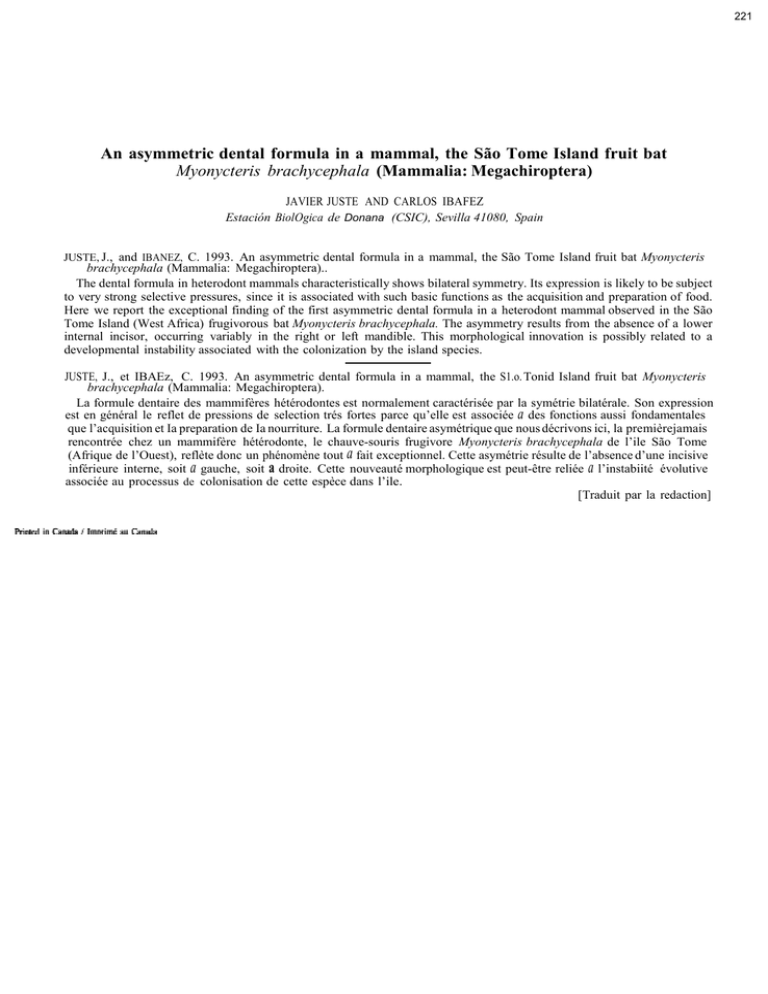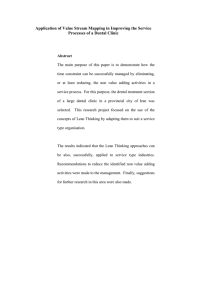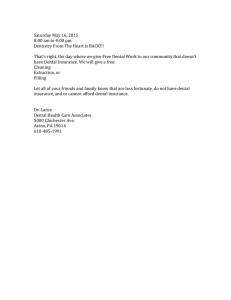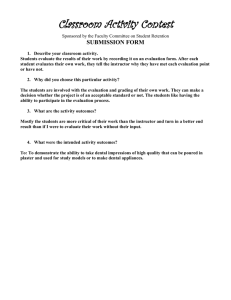1993 dentition myonycteris brachycephala can j zool.doc
advertisement

221 An asymmetric dental formula in a mammal, the São Tome Island fruit bat Myonycteris brachycephala (Mammalia: Megachiroptera) JAVIER JUSTE AND CARLOS IBAFEZ Estación BiolOgica de Donana (CSIC), Sevilla 41080, Spain JUSTE, J., and IBANEZ, C. 1993. An asymmetric dental formula in a mammal, the São Tome Island fruit bat Myonycteris brachycephala (Mammalia: Megachiroptera).. The dental formula in heterodont mammals characteristically shows bilateral symmetry. Its expression is likely to be subject to very strong selective pressures, since it is associated with such basic functions as the acquisition and preparation of food. Here we report the exceptional finding of the first asymmetric dental formula in a heterodont mammal observed in the São Tome Island (West Africa) frugivorous bat Myonycteris brachycephala. The asymmetry results from the absence of a lower internal incisor, occurring variably in the right or left mandible. This morphological innovation is possibly related to a developmental instability associated with the colonization by the island species. JUSTE, J., et IBAEz, C. 1993. An asymmetric dental formula in a mammal, the S1.o. Tonid Island fruit bat Myonycteris brachycephala (Mammalia: Megachiroptera). La formule dentaire des mammifères hétérodontes est normalement caractérisée par la symétrie bilatérale. Son expression est en général le reflet de pressions de selection trés fortes parce qu’elle est associée a des fonctions aussi fondamentales que l’acquisition et Ia preparation de Ia nourriture. La formule dentaire asymétrique que nous décrivons ici, la premièrejamais rencontrée chez un mammifère hétérodonte, le chauve-souris frugivore Myonycteris brachycephala de l’ile São Tome (Afrique de l’Ouest), reflète donc un phénomène tout a fait exceptionnel. Cette asymétrie résulte de l’absence d’une incisive inférieure interne, soit a gauche, soit a droite. Cette nouveauté morphologique est peut-être reliée a l’instabiité évolutive associée au processus de colonisation de cette espèce dans l’ile. [Traduit par la redaction] 2 Fin. 1. Detail in upper (above) and frontal (below) view of lower incisors of Myonycteris brachycephala. A unique inner incisor is always set in a central position, located variably in the left (A and B) or the right (C and D) mandible. Bilateral asymmetry in structural pattern is a primary feature of nonsessile animals (Romer and Parsons 1986; Gould 1989). Although there are examples of different types of asymmetry in living organisms (Neville 1976), there is no record of an asymmetric dental formula in either extant or fossil mammals. A partial exception is the narwhal (Monodon monoceros), which has only two permanent teeth in the upper jaw, one of which (normally the left) develops disproportionately in most males (Walker et a!. 1968). Symmetric dental formulae are therefore evolutionarily strongly fixed, being one of the most constant morphological characters of heterodont mammals and a feature commonly used for evolutionary and taxonomic studies. The São Tome fruit bat (Myonycteris brachycephala) is endemic to São Tome Island in the Gulf of Guinea (West Africa). The holotype, captured in 1868 and described by Bocage (1889), was the sole specimen known until it disappeared in a fire. In a revision of the suborder Megachiroptera, Anderson (1912) studied this holotype and recognized so many noticeable cranial and dental differences with respect to Myonycteris torquata, the closest continental species widespread throughout the rain forest block, that he placed M. brachycephala in its own subgenus, Phylletis. A new species, Myonycteris relicta, recently described from a small area in the eastern forest block (Bergmans 1980), completes this African genus. In the above-mentioned revision, Anderson referred in a footnote to the presence of three lower incisors. He pointed out that the single middle lower incisor completely filled the space between the two external ones but considered this an individual dental anomaly, since two pairs are characteristic of the genus. It was only in the last decade that a second specimen was obtained (Feiler 1984). During 1988 and 1989, we collected 19 new bats (8 males and 11 females) of this species from the islands of the Gulf of Guinea for a revision of the Chiroptera. The series shows a permanent dentition, all the specimens being adults, except for three subadults, according to cranial-suture and phalanx-ossification age criteria (Anthony 1988). The external lower incisors (12) in the new specimens are similar in size and shape. In all cases there is a single central incisor, clearly smaller, with a crown diameter no more than 3/4 of the diameter of the external ones (Fig. 1). This produces an asymmetric and exceptional dental formula. Because the mandibular symphysis is completely fused in all the specimens, at first sight it is not possible to identify the mandible to which it belongs. However, the ‘2 teeth of M. brachycephala have an asymmetric shape, with a more developed 223 NOTES anterior lobe that corresponds to the anterior cuspid of the same teeth in the closely related species M. torquata (Bergmans 1976). The odd incisor also presents one more developed lobe with a concavity lateral to it. The lobe is visible in the mid-incisor in 18 out of the 19 specimens. This fact, together with the asymmetry in the arrangement of the anterior mental foramina, as well as the distance from the 12 teeth to the respective canines and the differential wear of the central incisor crown cuspid in some individuals, shows that either the left (n = 13) or the right incisor (n = 6) may remain (statistically nonsignificant difference, x2 = 2.58, p = 0.108). Moreover, there is no evidence of a scar in any individual, including the younger ones, or any trace of a fourth alveolus. Asymmetries involving dental anomalies include unilateral hyperdontia and anodontia described for several mammals but always as rare individual characters (e.g., Van Valen 1964; Paulinov 1975; Wolsan 1984a, 1984b). In bats specifically, among African species these anomalies are more frequent in phytophagous species than in animalivorous ones (Eisentraut 1956) and have been also documented for American bats (Phillips and Jones 1969; Phillips 1971; Ramfrez Pulido and Mudespacher 1987). In neotropical frugivorous bats (subfamily Stenodermatinae), unilateral lower-incisor agenesis can reach 0.43% (n = 693) (Ramfrez Pulido and MUdespacher 1987), a probable overestimate since it may include some early loss of teeth. Such loss of a lower incisor has not been reported in the genus Myonycteris in the approximately 200 revised specimens of either M. torquata or M. relicta (Bergmans 1976, 1980; Schlitter and McLaren 1981), nor in the 55 specimens of M. torquaca in our own collection. Nevertheless, the anomaly in M. brachycephala could have been carried to the island by the first colonizing bats and could have become fixed in the population by a nondirectional mechanism. It seems more plausible to assume that the morphological asymmetry was part of the expression of either a structural gene mutation or a reordering of the initial genetic material (Muller and Wagner 1991), in line with the disequilibrium associated with a reduced founder population size (Mayr 1954; Levin 1970; Carson and Templeton 1984). This mechanism has been used to explain both dental and other anomalies in certain isolated populations (Van Vuren and Coblentz 1988; Bouwmeester et al. 1989; Sarre and Dearn 1991). Hence, genomic modifications capable of destabilizing dental development trends or of changing their epigenetic interactions (Waddington 1957; Oster and Alberch 1982) can stochastically inhibit the growth of either inner incisor. An alternative interpretation would be the existence of a median primordium which would come variably under the influence of right or left positional information; nevertheless, it seems less likely, since two different bones are involved. According to Van Valen’s (1962) classification of asymmetries, this would be a clear example of antisymmetry. Lower incisors apparently show scant functionality in bats (Slaughter 1970), therefore the asymmetry would be almost neutral. With the displacement of the remaining incisor toward the mandibular symphysis, both the plasticity and regulation of the implied systems (Muller 1990) would have permitted the asymmetry to persist. The small size of São Tome Island (836 km2), its oceanic character, and its relatively long distance from the continent (280 km) would have ensured the maintenance of the asymmetry by hindering genetic flow in an ecologically free environment. In fact, in contrast to the more than 10 species of a fruit bat guild in a West African continental community (Eisentraut 1963), São Tome Island is home to only three fruit bats (Feiler 1984). Unlike other conspicuous asymmetries (Neville 1976; Benkman and Lindholm 1991), this case illustrates the fixation of a nonadaptive asymmetry in nature. Acknowledgements We thank Eduardo Costas, Victoria Lopez Rodas, Pere Alberch, Miguel Delibes, Javier Castroviejo, and the Doñana staff for their stimulating discussions; J. E. Fa and J. Palmeirim for review of the manuscript, and L. Van Valen and an anonymous reviewer for helpful comments. The photographs were kindly made in the Museo de Ciencias Naturales, Madrid. This work was supported by the Spanish Instituto de Cooperacidn para el Desarrollo. Andersen, K. 1912. Catalogue of the Chiroptera in the collection of the British Museum. 1. Megachiroptera. Brstish Museum (Natural History), London. Anthony, E. L. 1988. Age determination in bats. In Ecological and behavioral methods for the study of bats. Edited by T. Kunz. Smithsonian Institution Press, Washington. pp. 47—58. Benkman, C. W., and Lindholm, A. K. 1991. The advantages and evolution of a morphological novelty. Nature (Lond.), 349: 519— 520. Bergmans, W. 1976. A revision of the African genus Myonycteris Matschie, 1899 (Mammalia, Megachiroptera). Beaufortia, 24: 189—216. Bergmans, W. 1980. A new fruit-bat of the genus Myonycteris Mat- schie, 1899, from eastern Kenya and Tanzania (Mammalia: Chiroptera). Zool. Meded. 55: 171—181. Bocage, J. v: 1889. Chiroptères de l’ile St. Thomé. J. Sci. Math. Phys. Nat. 2: 197—199. Bouwmeester, J., Mulder, J. L., and Van Bree, P. 3. H. 1989. High incidence of malocclusion in an isolated population of the red fox (Vulpes vulpes) in the Netherlands. J. Zool. (Lond.), 219: 123— 136. Carson, H. L., and Templeton, A. R. 1984. Genetics revolutions in relation to speciation phenomena: the founding of new populations. Annu. Rev. Ecol. Syst. 15: 97—131. Eisentraut, M. 1956. Beitrag zur Chiropteren-Fauna von Kamerun. Zool. Jahrb. Syst. Oekol. Geogr. Tiere, 84: 505—540. Eisentraut, M. 1963. Die Wirbeltiere des Kamerungebirges. Paul Parey, Hamburg. Feiler, A. 1984. Uber die Saugetiere der Insel São Tomb. Zool. Abh. Mus. Tierkd. 40: 75—78. Gould, S. J. 1989. Wonderful life: Burgess Shale and the nature of history. W. Norton and Co., New York. Levin, D. A. 1970. Developmental instability and evolution in peripheral isolates. Am. Nat. 104: 343—353. Mayr, E. 1954. Change of genetic environment and evolution. In Evolution as a process. Edited b J. Huxley. Allen and Unwin, London, pp. 157—180. MUller, G. 1990. Developmental mechanisms at the origin of morphological novelty: a side-effect hypothesis. In Evolutionary innovations. Edited by M. Nitecki. University of Chicago Press, Chicago. pp. 99—130. Muller, G., and Wagner, G. P. 1991. Novelty in evolution: restrucwring the concept. Annu. Rev. Ecol. Syst. 22: 229—256. Neville, A. C. 1976. Animal asymmetry. Inst. Biol. Stud. Biol. No. 67. Oster, G., and Alberch, P. 1982. Evolution and bifurcation of developmental programs. Evolution, 36: 444—459. Paulinov, Y. 1975. Tooth anomalies in some Canidae. Acta Theriol. 33: 507—519. 224 CAN. J. ZOOL. VOL. 71, 1993 Phillips, C. J. 1971. The dentition of Glossophaginae bats: development, morphological characteristics, variation, pathology and evolution. Misc. Publ. Univ. Kans. Mus. Nat. Hist. No. 54. Phillips, C. J., and Jones, J. K., Jr. 1969. Dental abnormalities in North American bats. I. Emballonuridae, Noctilionidae, and Chilonycteridae. Trans. Kans. Acad. Sci. 71: 509—520. Ramirez Pulido, J., and MUdespacher, C. 1987. Formulas dentarias anormales en algunos murcielagos mexicanos. Acta Zool. Mex. (n.s.), 23: 1—54. Romer, A. S., and Parsons, T. S. 1986. The vertebrate body. CBS College Publishing, Philadelphia. Sarre, S., and Dearn, J. M. 1991. Morphological variation and fluctuating asymmetry among insular populations of the sleepy lizard, Trachydosaurus rugosus Gray (Squamata: Scincidae). Aust. J. Zool. 39: 91—104. Schlitter, D. A., and McLaren, S. B. 1981. An additional record of Myonycteris relicta Bergmans, 1980, from Tanzania (Mammalia: Chiroptera). Ann. Carnegie Mus. 50: 385 —389. Slaughter. B. 1970. Evolutionary trends of chiropteran dentition. In About bats. Edited by B. Slaughter and D. Walton. Southern Methodist University Press, Dallas. pp. 51— 83. Van Valen, L. 1962. A study of fluctuating asymmetry. Evolution, 16: 125—142. Van Valen, L. 1964. Nature of the supernumerary molars of Otocyon. J. Mammal. 45: 284—286. Van Vuren, D., and Coblentz, B. 1988. Dental abnormalities of feral goats (Capra hircus) on Aldabra atoll. J. Zool. (Lond.), 216: 503 —506. Waddington, C. H. 1957. The strategies of the genes. Allen and Unwin, London. Walker, E., Warnick, F., Lange, K., Uible, H., Hamlet, S., Davis, M., and Wright, P. 1968. Mammals of the world. Vol. 2. 2nd ed. The Johns Hopkins Press, Baltimore. Wolsan, M. 1984a. The origin of extra teeth in mammals. Acta Theriol. 10: 128—133. Wolson, M. 1984b. Concerning the variation in the number, shape and size of incisors in fissiped carnivores. Acta Zool. Cracov. 6: 107— 129.




